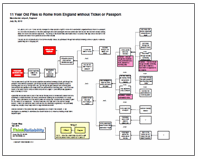Knife cuts in restaurants pose a big risk, not only to the restaurant employees themselves, but also to customers due to the potential risk of contamination by blood or bandages as a result of an employee who receives a laceration due to a knife cut. There are steps that can be taken to reduce the risk of a knife cut. While some of these steps can be taken by restaurant employees themselves, many will involve the restaurant management as well. Although these recommendations are based on knife cuts that occur within the restaurant and food preparation industry, they are also relevant for use at home to protect against lacerations from knives.
 You can view some different causes that can result in lacerations from knives in a Cause Map, or visual root cause analysis, by clicking “Download PDF” above. With any root cause analysis, the goal is to determine as many solutions as possible to reduce the risk of the issue – in this case, knife cuts – from happening in the future. When we put together a proactive investigation – not based on one specific incident, but rather combining any possible causes we can brainstorm to best determine solutions – we can use some examples of actual lacerations that have occurred, and also our personal experiences to brainstorm causes. As with any investigation, the wider net we cast, the more ideas we brainstorm and the more possible solutions we can discover.
You can view some different causes that can result in lacerations from knives in a Cause Map, or visual root cause analysis, by clicking “Download PDF” above. With any root cause analysis, the goal is to determine as many solutions as possible to reduce the risk of the issue – in this case, knife cuts – from happening in the future. When we put together a proactive investigation – not based on one specific incident, but rather combining any possible causes we can brainstorm to best determine solutions – we can use some examples of actual lacerations that have occurred, and also our personal experiences to brainstorm causes. As with any investigation, the wider net we cast, the more ideas we brainstorm and the more possible solutions we can discover.
The setup of the food prep area is key to reducing cuts. Inadequate lighting and distraction can lead to increased injury, as can the storage location of the knives. (You’re much more likely to cut yourself grabbing a knife out of a drawer than off a magnetic strip or out of a block.) The condition of the knives themselves is also key. Properly maintained knives – that is, knives that are sharpened and the handles are properly attached – are less likely to cause cuts because dull knives, or those with loose handles, make it difficult to cut properly, increasing the risk of cuts. Knives should be regularly sharpened and if a knife is damaged, it should be disposed of. In addition, having the proper compliment of knives is important. Proper cutting technique can reduce knife cuts, but a key component to proper cutting technique is having the correct knife.
An additional component of proper cutting technique is training. Training should include techniques for cutting as well as which knife to use for which type of cutting and what kind of food product. Some of the key aspects to knife cutting technique that can decrease the incidence of knife cuts include: cut away from you, using a cutting board with a mat to keep it from slipping. Hold objects with your fingers pointing straight down, using your knuckles as a guide for the knife. It’s very difficult to cut yourself while holding a knife this way.
Not all knife cuts occur while cutting food. One frequent source of knife cuts is reaching into a sink full of soap water and grabbing a knife blade. When hand washing knives, put it one knife at a time and don’t let go of it. Always set knives well onto the counter with the blade facing away from you. And if a knife falls off a prep surface, step back and let it fall. If you are particularly concerned about knife cuts, you may want to consider the use of Kevlar gloves. Restaurants that use Kevlar gloves have seen a remarkable decrease in injuries due to knife cuts.
To view the Cause Map, please click “Download PDF” above




